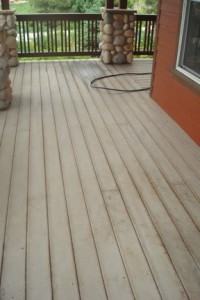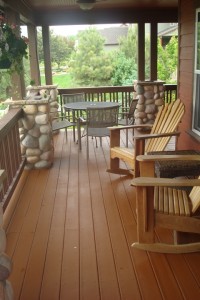Jun
30
2009
As recently noted in the LA Times Blog, Los Angeles is offering homeowners up to $2,000 to replace their lawns with a sustainable landscape. Other cities such as Las Vegas have done this aggressively. In the blog, it is noted that Las Vegas has removed enough lawns to save 7 billion gallons of water a year, or about one-tenth of their annual water supply. Closer to home, Aurora has had such a program for years offering $1 per square foot for turf that is removed, the same as LA. While I don’t know how successful the program has been overall, I have worked with several HOA’s to reduce the turfgrass they have, and create more appealing communities in the process.
So when is Fort Collins and other Northern Colorado communities going to do the same thing? We keep preaching about water conservation, xeriscape, etc., but no money where the mouth is. Also, other communities such as Aurora and Castle Rock have more restrictions on creating water thirsty landscapes in the first place. When is Northern Colorado going to catch up? Did you know, that in the engineering standards for road design in Larimer County, which Fort Collins and Loveland use as well, it actually requires turf grass to be planted in the parkway strips? This is non-sense. Time to get on the bandwagon and really pay attention to this stuff before the next drought hits.
2 comments | tags: Development, green building, street scape, sustainability | posted in Development, Landscape Architecture
Jun
17
2009
The Star Tribune in Minneapolis recently reported on a historically designated home that has fallen into foreclosure. That is bad enough, but apparently thieves have broken in and pretty much stripped the place of all the cool details that made it historical. This is really sad, and is something that preservation forces should be on watch for happening in other areas. However, this isn’t limited to just historical homes. In many parts of the country, such as Detroit, Las Vegas, and Phoenix, vandels (or the foreclosed owners themselves) are stripping homes of anything of value such as sinks, toilets, light fixtures, cabinets, even furnaces. I remember when I was looking for my first home during that last real estate meltdown in Denver in the late 1980’s, I found some places with the same thing…no cabinets, light fixtures, etc. Pretty sad.
In Suprise, AZ though, they are beginning to prosecute people for this, as reported by Jay Thompson on his blog, The Phoenix Real Estate Guy.
1 comment | tags: Development, green remodel, sustainability
Jun
4
2009
 Those of us in design and building industries, and particularly those of us that focus on green building, always like to use more environmentally correct products whenever possible. When I started building 10 years ago, are homes always had large front
Those of us in design and building industries, and particularly those of us that focus on green building, always like to use more environmentally correct products whenever possible. When I started building 10 years ago, are homes always had large front  porches, and they still do. At the time, all of our porches were wood framed, and we used Trex decking in lieu of Redwood as the surface material. Trex is considered a green product since it uses a lot of wood scraps in its making, never needs staining, won’t warp, rot, or splinter. I totally agree with all of this, except for the staining part. We have had a Trex porch for nine years now. I do truly like the product, but after nine years, it was starting to look pretty grungy. There have been wine spills, paint spills, and water stains. I have cleaned it several times, but to no avail. So I finally decided to stain it, using a stain that was approved by Trex. In my case, I used a solid color stain by Behr. I also put down two coats. First, I was amazed at how well Trex took the stain, and second, I was amazed at how the stain covered over all of the spots, including the paint spills. I was hoping for them to not be as noticeable, but they are simply gone now. The porch looks brand new, and now matches the paint scheme of our house. Now we shall see how long the stain lasts. BTW, in case you are keeping track, the Behr stain is water based, does not off gas, and cleanup was with water. That is pretty green in itself.
porches, and they still do. At the time, all of our porches were wood framed, and we used Trex decking in lieu of Redwood as the surface material. Trex is considered a green product since it uses a lot of wood scraps in its making, never needs staining, won’t warp, rot, or splinter. I totally agree with all of this, except for the staining part. We have had a Trex porch for nine years now. I do truly like the product, but after nine years, it was starting to look pretty grungy. There have been wine spills, paint spills, and water stains. I have cleaned it several times, but to no avail. So I finally decided to stain it, using a stain that was approved by Trex. In my case, I used a solid color stain by Behr. I also put down two coats. First, I was amazed at how well Trex took the stain, and second, I was amazed at how the stain covered over all of the spots, including the paint spills. I was hoping for them to not be as noticeable, but they are simply gone now. The porch looks brand new, and now matches the paint scheme of our house. Now we shall see how long the stain lasts. BTW, in case you are keeping track, the Behr stain is water based, does not off gas, and cleanup was with water. That is pretty green in itself.
3 comments | tags: green building, sustainability
May
20
2009

Tonight we obtained Planning Commission approval for the Midori project I have been working on for awhile. The next step is County Commissioners. This project still continues to generate solid interest in the lots and homes, and stands a good chance of being sold out by ground breaking! Here is the current site plan. For more information on this sustainable project, visit www.midoriliving.com
no comments | tags: Development, green building, LEED, new urbanism, street scape, sustainability
May
13
2009
Recently, there was an article in the New York Times about a suburb in Vauban, Germany where cars are basically outlawed. Street parking, driveways, and home garages are forbidden within the community. If you do have a car, you have the option of purchasing a garage space on the outskirts of the community to park it in…at a mighty premium. From what I gather, this community is wildly popular among the eco-friendly and executives alike. This community works where it is, because it happens to be located along a tram line with a direct link to downtown Frieberg, and connections to the commuter rail. Compared to the United States, it is widely known that Germany and the rest of Europe have a very comprehensive and successful public transportation system, that makes living car free for entire communities possible.
Can it work here? In my opinion, it can in limited locations across the country. Indeed, you can find people almost anywhere that don’t have cars, either because they can’t afford one, or choose not to have one, and they get along fairly well. But for an entire community? I say, this won’t happen on a large scale in this country until we start thinking about the common good, with a look at the long term, and start putting some real emphasis on creating a viable public transportation system, that actually goes somewhere. I am not talking about just Fort Collins, but the country as a whole. People have to be mobile, and to go without cars, there needs to be a way to get from point A to point B in a relatively short period of time. We are starting to see signs of life on this front, but we have a long way to go. Of course, this will also require more compact development patterns. Indeed, in Vauban, single family homes are not generally permitted. Basically the community is a TOD project, but taken one step further.
To further this goal and concept, I think we also need to get away from the idea that homes must face paved public streets. Why does a street have to have 30-50 feet of asphalt to function as a public street? Why can’t homes face “green streets”? Instead of asphalt, why not landscaped courtyards? This would also serve as a place to play for kids that is close to home…and allow for smaller lots and denser developments. I have been pushing this concept for years with some success. A current project that I am working on is attempting to do this. I have blogged about Midori before, with more coming soon. The battles I face in trying to do “green streets” is how do we address the homes without a paved street, how to get utilities to them without a front door, and the real issue of fire access. Of course, people also have to get away from the idea that they have to have a garage attached to the home. There are some communities that have been successful at this, including co-housing communities, and many of the communities built by The Cottage Company Interestingly though, many other builders who try to build off the concept of The Cottage Company include attached garages now.
I would love to find an infill piece of ground to create a car free community in Fort Collins. Anybody want to join me on this?
no comments | tags: Development, green building, new urbanism, street scape, sustainability








